Your cart is currently empty!
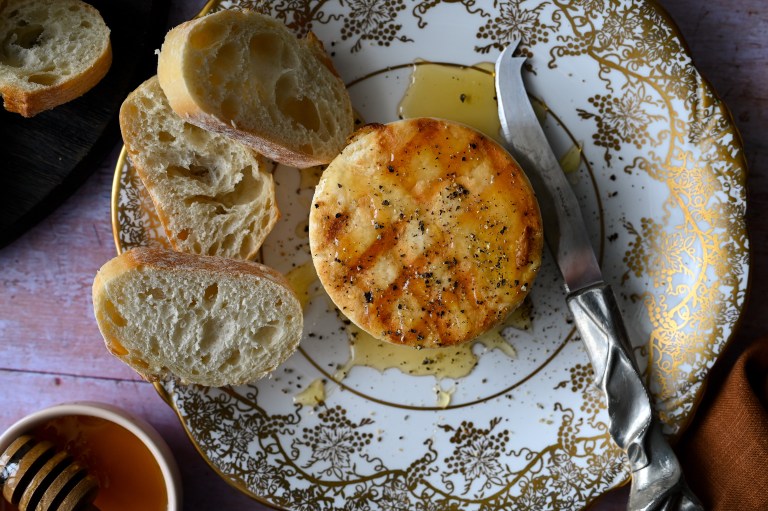
Taking the guesswork out of Greek cooking…one cup at a time

Vasilopita (or Basilopita) is a perfectly sweet and flavourful New Year’s Cake!
Ever wonder why, in most Greek families, names seem to be on repeat? At any family function you are likely to find 4 Marias, 3 Costas and about 7 Georges. That’s because Greek parents have traditionally always named their children after their own parents. So, two siblings who each have daughters, may very well name their girls after their common mother, for example. Many Greek names are also names of Saints, making the Nameday (the day on which we commemorate the life of a given Saint) a much bigger deal amongst many Greeks than birthdays could ever be. Each of us is named after one of our grandmothers, and one of our Greek names (Vasiliki) is also associated with Saint Basil the Great, who is commemorated on January 1st, the day of his death.
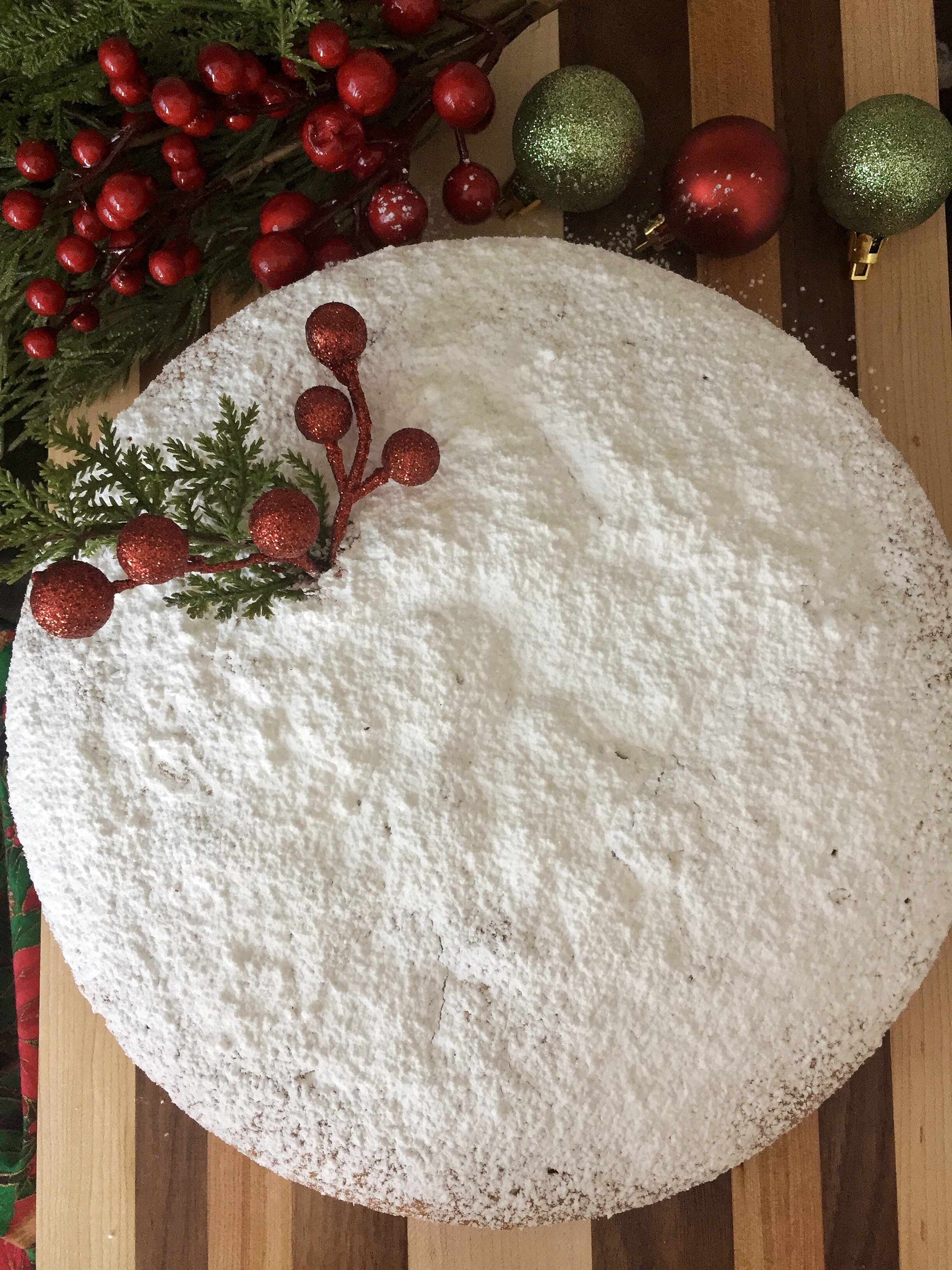
St. Basil the Great was the Greek bishop of Caesarea Mazaca in Coppadocia, in Asia Minor (what is today, Turkey). In addition to his theological works, he was also a great support for the underprivileged and poor. In his memory, on St. Basil’s Day, homes of Orthodox Christians serve vasilopita (translated to mean St. Basil’s bread) to honour him. Although there are many versions and types of vasilopita, they all have one thing in common; there is a single coin baked into each one. This coin is a symbol and reminder of St. Basil’s intervention against the emperor of Caesarea, and God’s miracle. One year, the emperor of Caesarea had levied a heavy tax on the people, during a year of great famine and hardship. Upon hearing the news, St. Basil asked the emperor to repent, and he did. The emperor ordered that all gold coins, money and jewels that the people had used to pay this tax, be returned to them. Bishop Basil was assigned the daunting and overwhelming task of doing so. Unsure of how to return the goods to their rightful owners, prayer led St. Basil to bake a large pita, into which he inserted all the valuables. He then called the townspeople to each take a piece. Miraculously, each person received a piece of vasilopita that contained the exact items which were to be returned to them.
In our family, vasilopita is always served after lunch on the Feast Day of St. Basil, which is coincidentally also New Year’s Day (January 1st) for many. Our father is typically the person who cuts and serves the pieces, and this is done in a particular order. The first piece is cut and saved for Christ, the second for St. Basil, and the third for the less fortunate. Then, a piece of vasilopita is cut for all members of the family, and any friends who may be present. The vasilopita is always offered to the oldest person present, up until the youngest. The person whose piece contains the coin is expected to have good luck and blessings for the upcoming year.
Karydopita, Greek walnut cake, is another one of our crowd pleaser cakes, see video below:
Helpful hints
There are many ways to bake a vasilopita. Some versions are very bread-like, and similar to the Easter tsoureki. Other versions, like our parents’ recipe which follows, are more cake-like. Both are delicious, but different. Besides the obvious flavour and texture differences, another difference between the two is that with the bread type of vasilopita you can usually use a bit of the dough to roll out the numbers of the year, which is then laid on top of the bread before baking. You can’t really do that with this recipe. If you would like to have the year showcased on your vasilopita however, you can either decorate it with sliced almonds, or use a stencil with the year cut out of it, on top of the cake before you sprinkle it with icing sugar. Our parents would sometimes do this, but not usually. They always reminded us that this was not a New Year’s cake, but a cake to commemorate the Feast Day of St. Basil.
Although you will grease your cake pan with some vegetable oil, is it still a very good idea to line the bottom of the pan with parchment paper. The easiest way to get just the right size of parchment paper for the bottom of your round pan is to place your baking pan on a sheet of parchment paper and to trace its outline with a pencil. Then, use a scissor to cut out the perfect circle. Ta da!
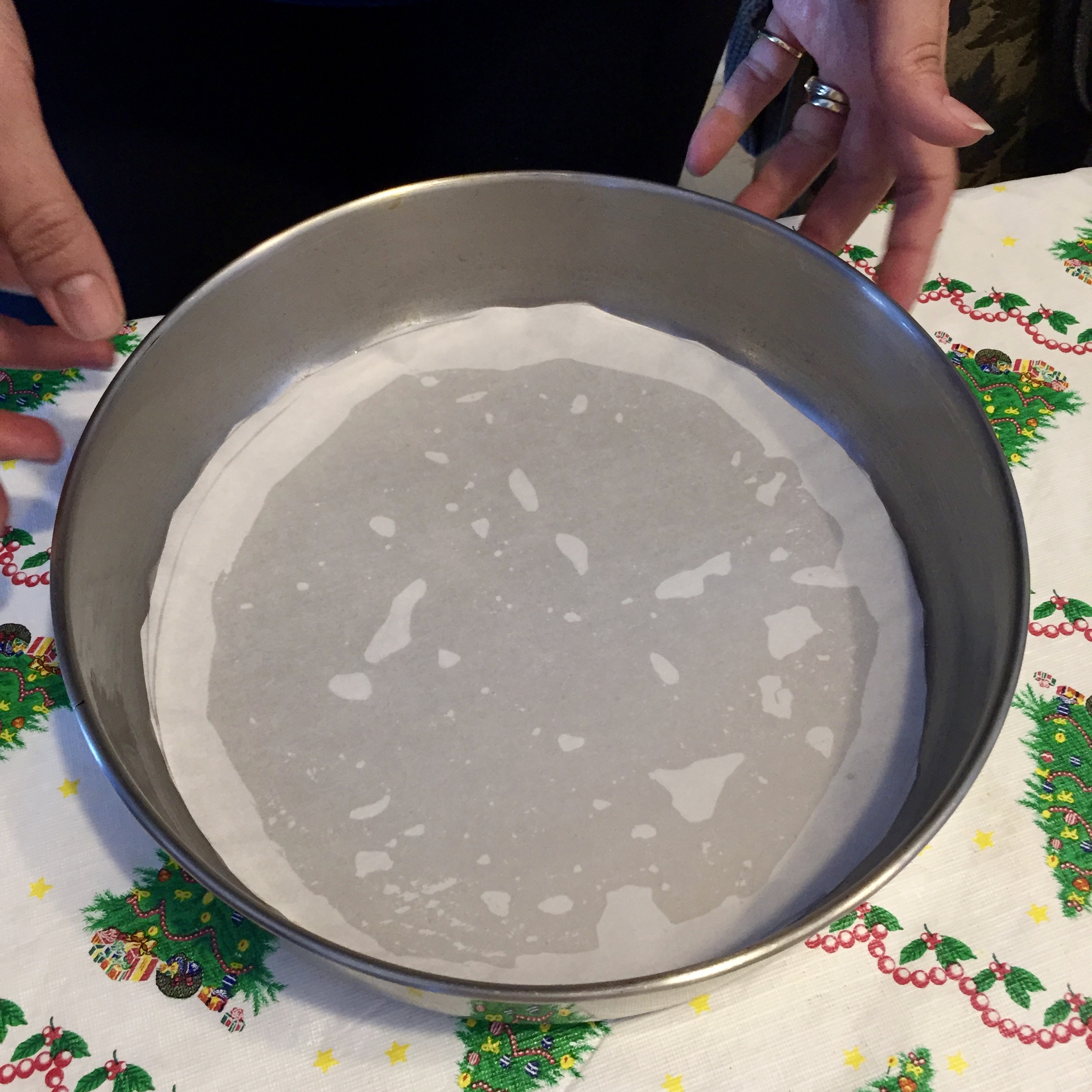

Before inserting the coin into your cake batter, it is a very good idea to wash it and to then wrap it with either food grade plastic wrap or aluminum foil. You can even use parchment paper, although that can be a little more cumbersome to wrap the coin in. Traditionally, before inserting the coin into the cake you would use it to make the sign of the cross over the pan. The easiest way to get your coin into the batter is to use a knife to make a small cut into the batter and slip the coin right in. Spread the batter evenly so that it is not obvious where the coin is.
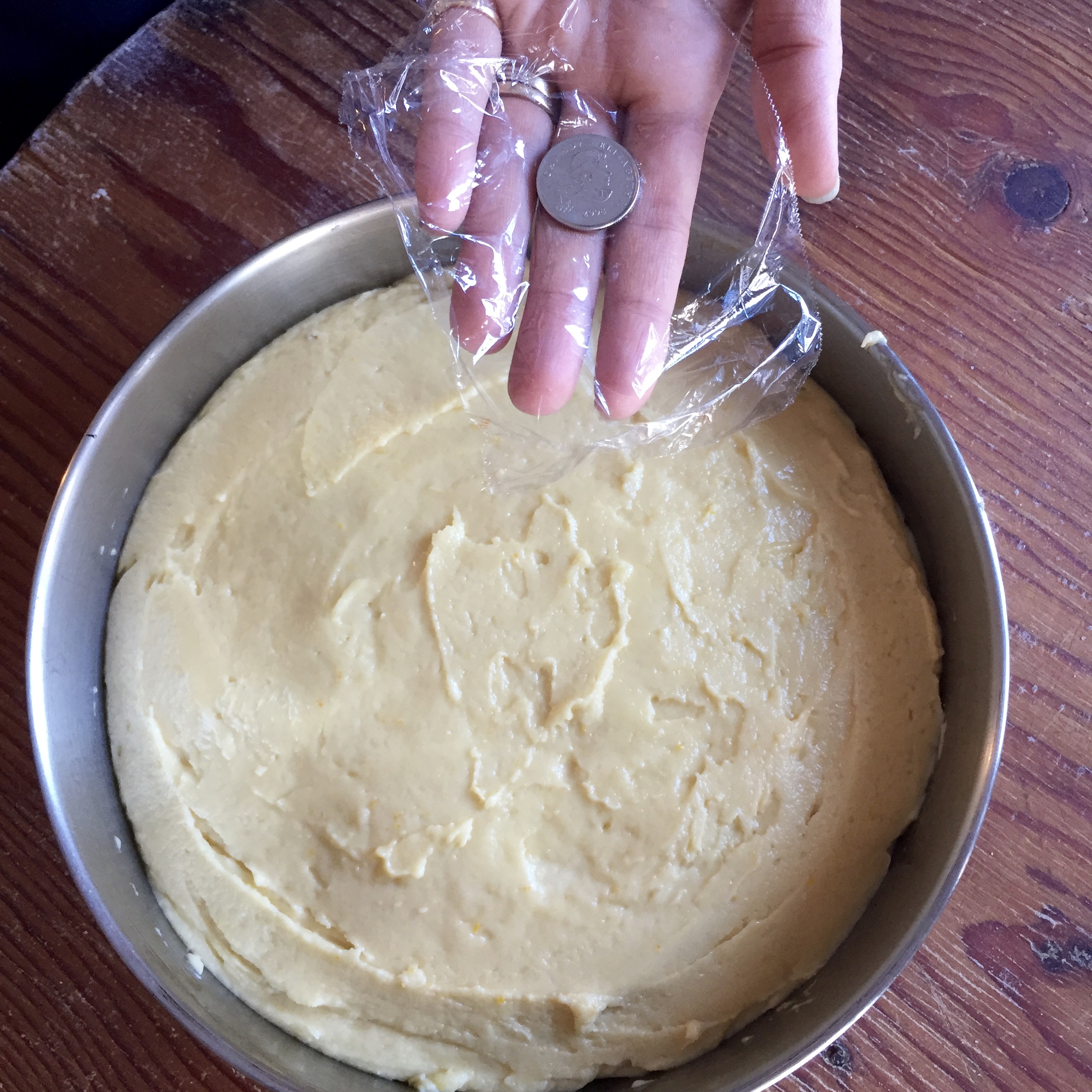

Eating cake or bread with a coin hidden in it could definitely be a choking hazard, so please…if you are serving vasilopita to the very young or the very elderly, be careful. We remember that when we were little, our parents would often tear our pieces apart before allowing us to eat them, being sure that if there were a coin in there, it would be found before it ended up in our mouths. Now that we think of it…we can’t remember a year when one of the children didn’t actually get the coin. Coincidence? Maybe…or perhaps clever serving by our dad. It was always such a thrill to find the coin!
This cake keeps really well and is even more delicious if made the day before. This is also a great option because it means that your cake will have ample time to cool fully before you sprinkle it with icing sugar.
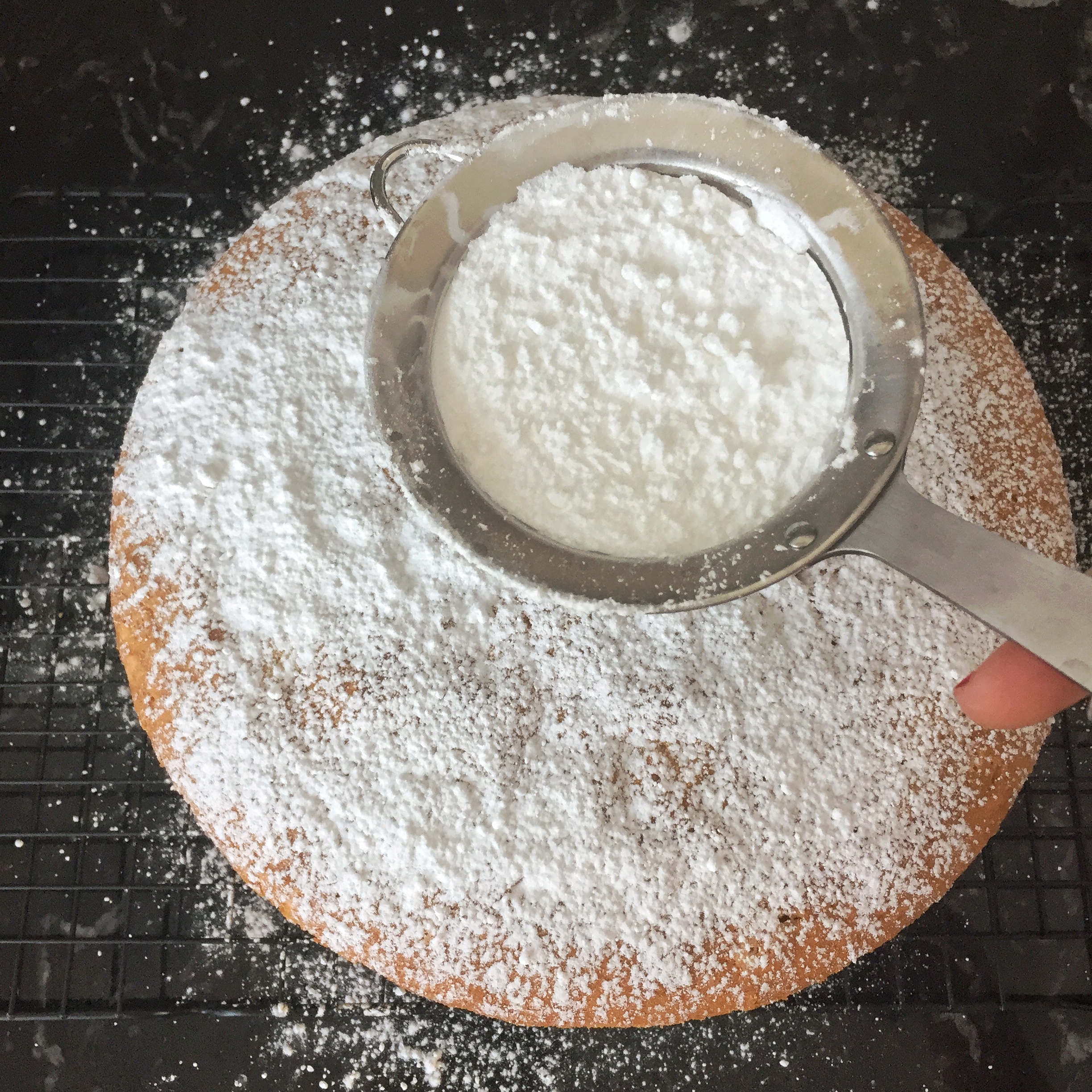
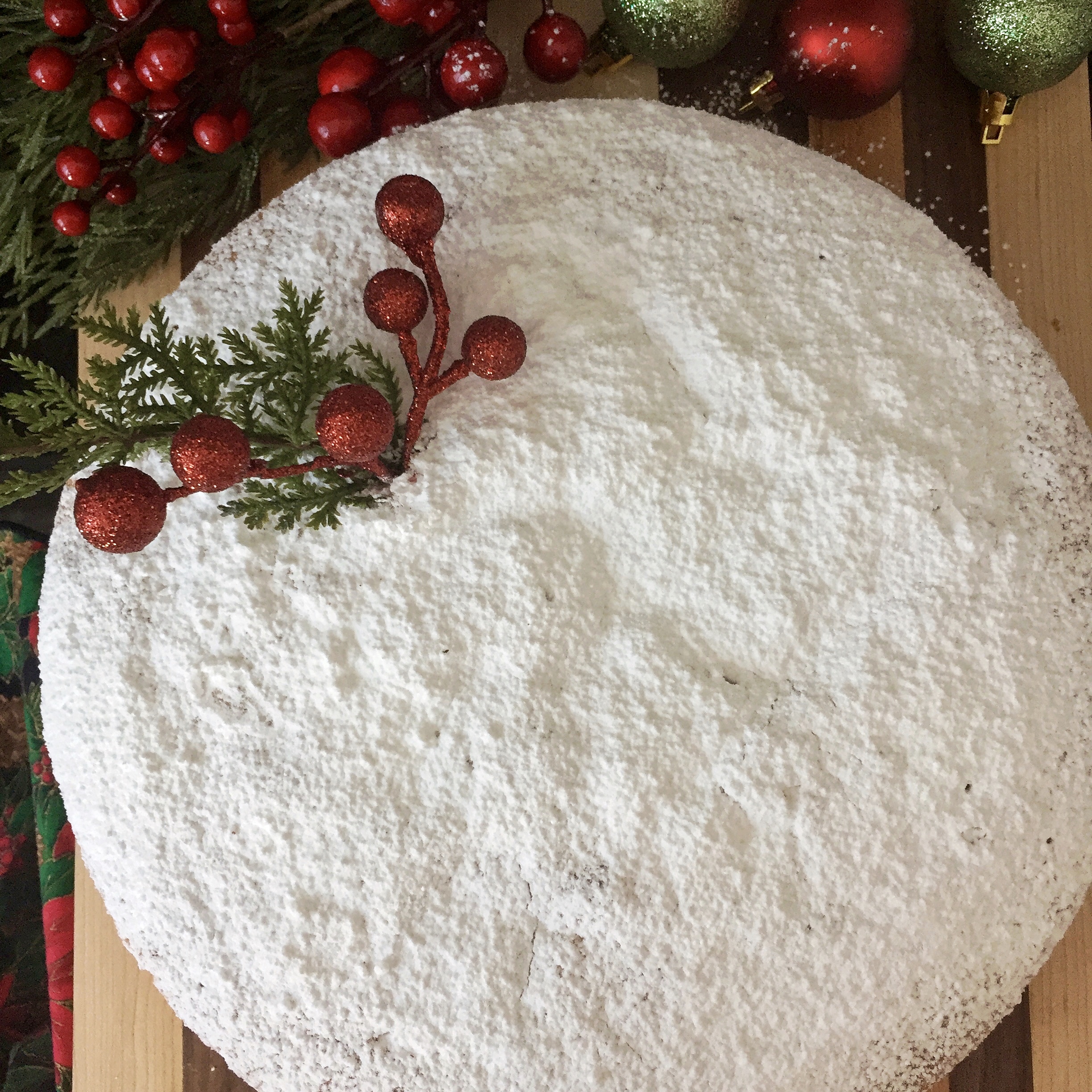
Looking for some more festive desserts? Try these:
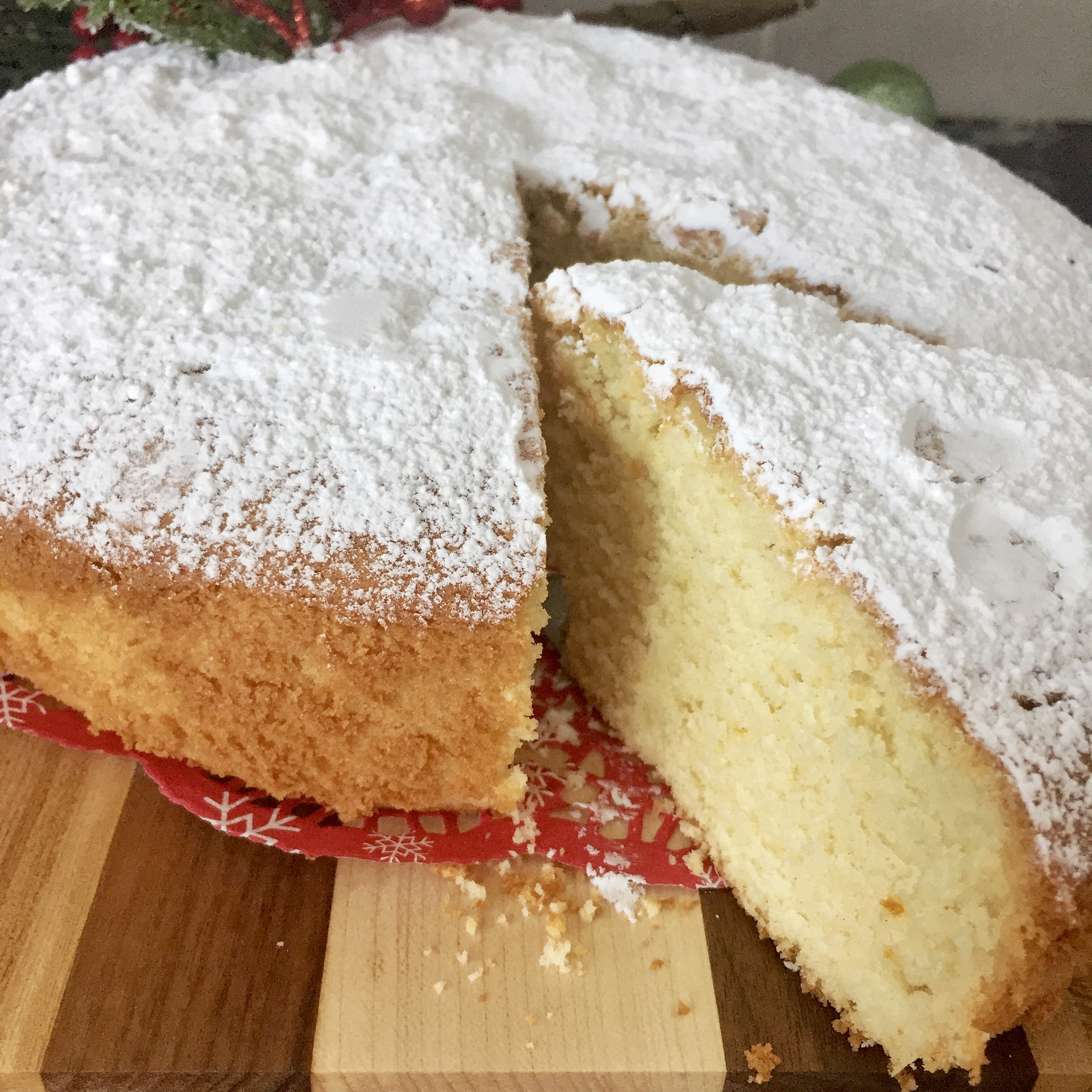
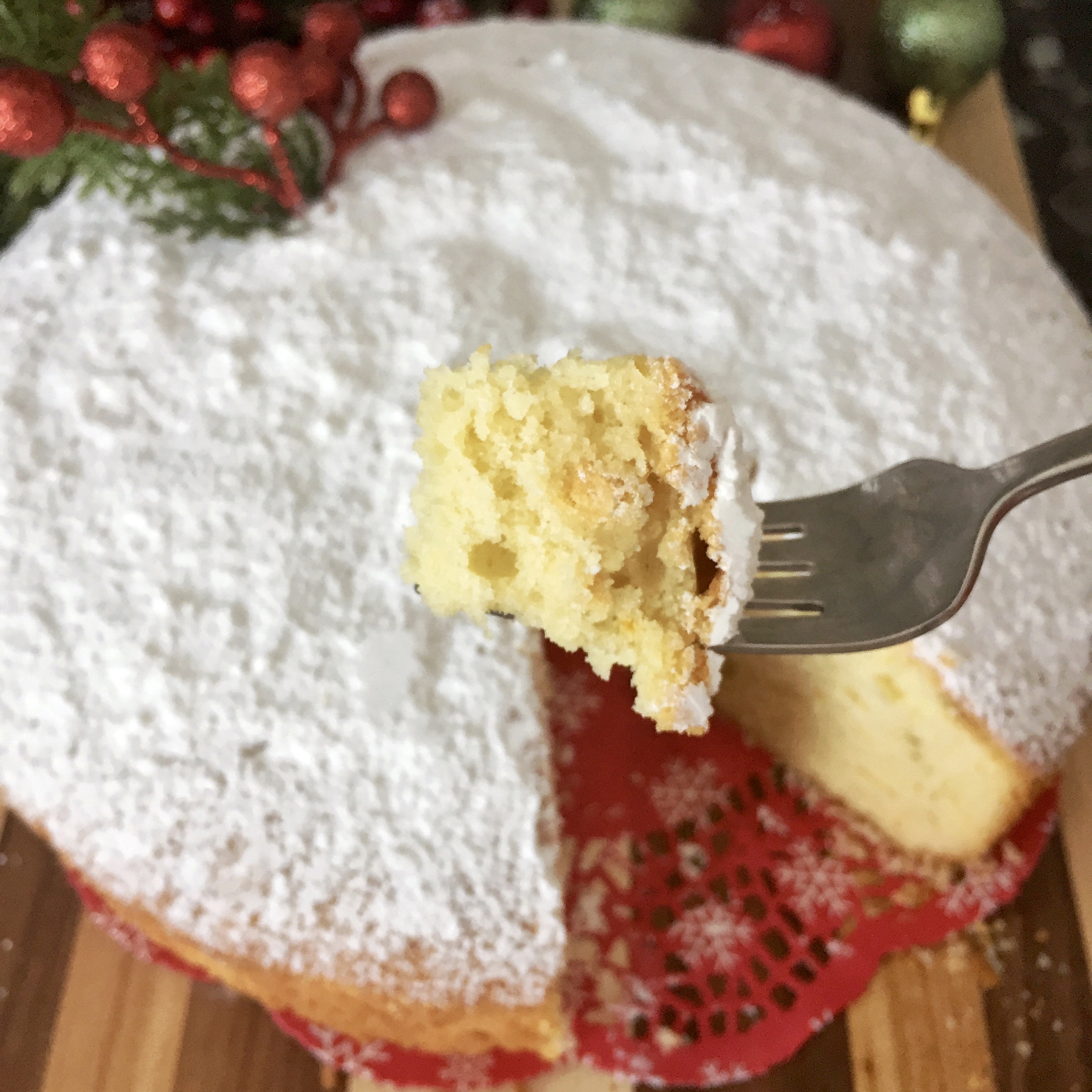
We love hearing from you! If you have made our recipes, or if you have a question or comment, or simply want to say Hi!, please leave a comment and star rating below! Also be sure to follow along with us, on Facebook, Instagram and Pinterest. We have lots of fun over there.
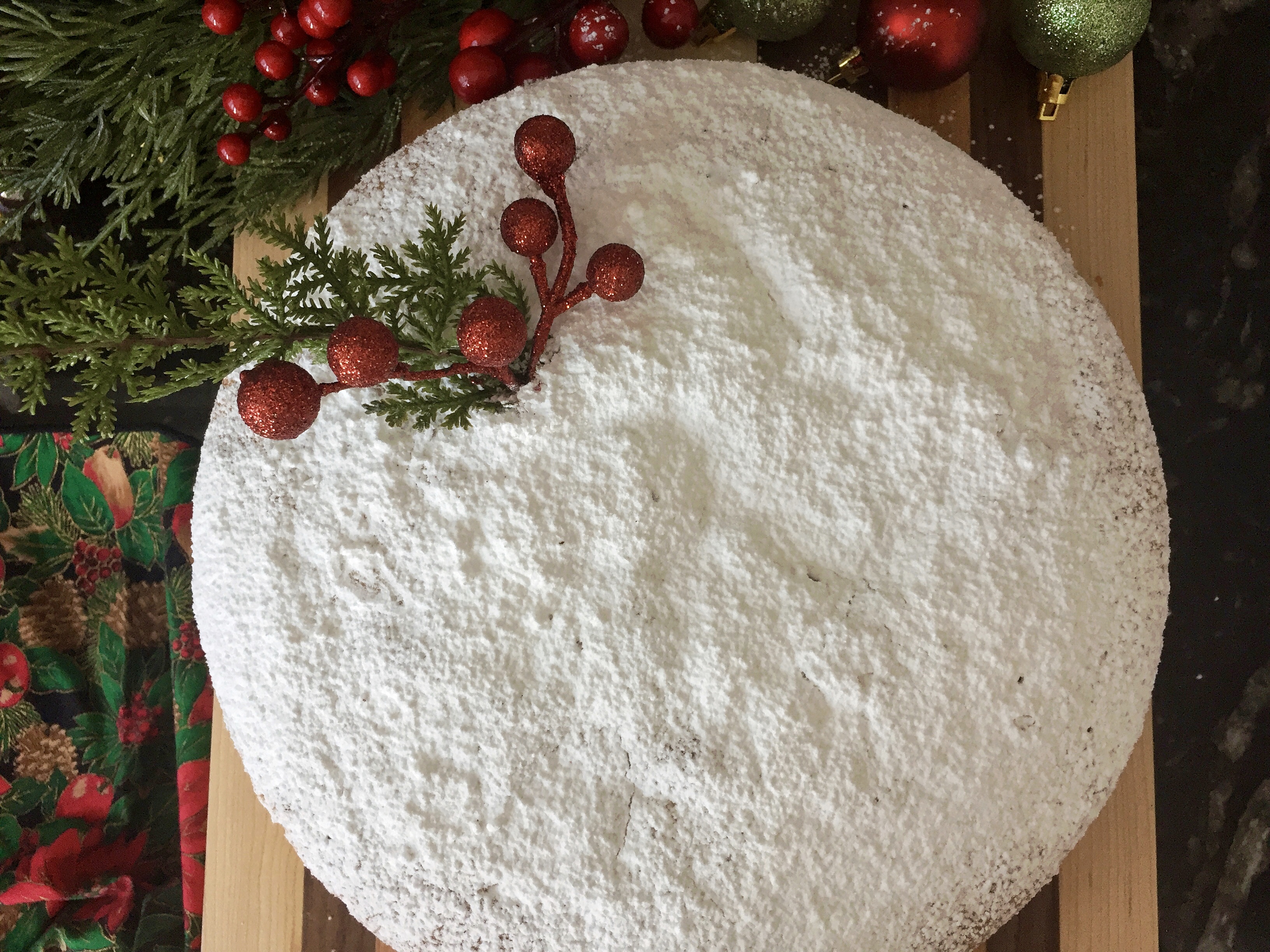
Awesome ! Look so beautiful & spongy !!
Thank you! It is very moist and quite delicious actually. Hoping you give it a try 🙂
Coin in cake interesting 🙂
Yes! It is a lovely tradition that is actually found in many cultures. Just be sure to wash and wrap the coin! 🙂
I enjoy reading about other cultures. The Greek culture and traditions are old and rich and hope that you continue to inform us about them. You have a fun and simple way of explaining them. Also, your pictures are so good that I can smell the vanilla and brandy perfume just by looking at the pics. Thanks again for your truly enjoyable blog. Happy New Year and more importantly Happy Feast Day of St. Basil!
Thank you so much Marina for your kind words of encouragement. Knowing that our posts bring pleasure to people, and that they are helpful, makes the hard work really worth it. Your comments are very motivating. 🙂
What a lovely tradition and the cake sounds and looks perfect for such a festive occasion.
Thank you so much Karen. It is a lovely addition to the celebration 🙂
Thanks, I was searching recipes yesterday and I had a feeling you would post one that was perfect. I can’t wait to make it
Χρόνια πολλά
Thank you so much Connie! We hope you enjoy this recipe. 😊 Χρόνια Πολλά και ευτυχισμένος ο καινούργιος χρόνος.
I just had to come back and comment.
What a great cake! Nicest vasilopita I’ve ever eaten, was enjoyed by my family and friends. Thank you this will be a yearly tradition from now on.
Oh wow!! Thank you so much Connie for taking the time to come back and give us your feedback! It made our year 🙂 So happy that your family and friends enjoyed it and that you were happy with the result! Yeah! Happy New Year and all the best in 2018!
I order Vasilopita from our church but someday I’m going to try and make one. I always looked forward to cutting a loaf with my yiayia. I got the coin several times! Happy New Year!
Ordering your vasilopita from church is wonderful, but if you do decide to make one some day, hope you’ll give this recipe a try 🙂 It’s super easy! Χρόνια Πολλά to you and your γιαγιά…and the rest of your family 🙂
This brings back memories. Iemember having cakes with coins in them growing up as a kid too.
We love it when our posts and recipes bring back memories! Happy New Year!!
This is the second year that i am making Vasilopita using your recipe! It has always been a tradition in our home for as long as i remember! So happy to be able to share this tradition with my daughters and loved the look on Yiayias face when she said… “this is so good, bravo” Happy New Year!
Wonderful! Happy New Year and all the best in 2018
I so enjoyed reading a little about Greek culture and the origins of this “money-cake” 🙂
Thank you so much for stopping by and your kind words 🙂 We’re happy that you enjoy our posts! Have a great day!
Your just awesome I am Greek also xpovia polla and your soo positive and sweet God bless you
With love❤️
Xpisiva
Thank you so much Christina for your kind comment! We are so happy that you found us 🙂 Wishing you a very happy new year and a 2019 full of love and laughter, health and peace.
Hello. Thanks for sharing your family recipe! Our family usually does a more bread-like version but I would like to try out your recipe since it’s quicker. I may be making one for my son’s Kindergarten class so don’t want to use any alcohol. What would you reccomend to substitute for cognac/brandy? More vanilla? Almond extract? Also, do you think I could get away with two 8 inch pans for the amount of batter here? Thanks!
You’re welcome Elayne!! Sorry it took us a few days to get back to you (holidays were busy!!). You can easily substitute orange juice for the alcohol and it would be just as delicious we think. As for the pans, one of us actually made it in two 8 inch pans this year…lower the cooking time a bit, but otherwise everything is the same and it worked out perfectly. Hope this helps..and that it isn’t too late 🙂 Happy New Year!
Happy New Year! Thanks for this recipe! It came out perfect – nice and fluffy and delicious! My family loved it!
You just made our year!! 🙂 Thanks so much for letting us know, and for making Mia Kouppa part of your New Year’s celebration. xoxo
I WOULD LIKE TO PRINT VASILOPITA
Hi Sophie! You should be able to see the “print” option in the recipe box for Vasilopita. Let us know if you have difficulties.
3rd year I bake my own vasilopita, 3rd recipe I try…this one’s a keeper. Absolutely loved it, super tasty and moist, everyone raved about it!!
Oh we are so happy to hear that Theoni!! Thank you so much for trying our recipe and making Mia Kouppa part of your New Year’s celebration. Happy 2020 to you and your family 🙂
I love your Greek recipes thank you especially holiday season
Thank you so much Sophie! We hope that you had wonderful holidays and happy 2020. We really appreciate you taking the time to comment!
I need to make a vasilopita for 20 people this weekend. Can you double this recipe? If so, what size pan should I use?
Hi Betty! We are really reluctant to suggest doubling baking recipes, especially when we have not tried doing it ourselves. Our suggestion would be to make the cake twice. More work, but may be a safer option.
[…] Vasilopita, (Also known as king pie or basil-pie) made only for New Year’s and only eaten on New Year’s Day. This Greek New Year’s cake is sweet, bready, and topped with almonds. Traditionally, the cake is baked with a coin or trinket, and the person who gets that slice is supposed to have good luck for the year ahead. […]
Thank you so much for this recipe! I want to make a smaller one, is it ok if I just half everything?
Hi Jenny! For sure you should be able to half the recipe easily. Enjoy, happy baking, and Happy New Year!! xoxo Helen & Billie
Last year I made your vasilopita recipe with a 9 inch dark coated pan and it came out perfect. This year I used a 10 inch Wilton cake pan and the top domed and cracked and the very center (about one inch around) wasn’t fully cooked at 55 mins but the outsides were plenty dark. Seems it’s more difficult to bake a 10 inch pan because the outside cooks faster than than center, which is exactly what happened to me this time. I followed the instructions exactly. What is recommended?
I think next year I’ll try the 9 inch pan again but would appreciate any tips. Thank you.
Hi Tassia!! Thanks for sharing your experience with our vasilopita recipe – it is true that pan size (and colour) can make a difference in baking. It sounds as though this year your oven was too hot however. Sometimes, even if you set your oven to the right temperature, the actual temperature in the oven is different. We actually think that this year we will create a post on baking, with some common issues, along with trouble shooting. Happy New Year!! xoxo Helen & Billie
I had the exact same issue. I kept the cake in the oven much longer and I am hoping it’s not dry. I made 2 cakes and tried both with and without convection and had the exact same results with the center not cooking fully.
Hi Margarita! Sorry for the late reply. A cake that is not fully cooked in the center may have a couple of causes. First, your oven temperature may not actually be what you set it to. If this is a common problem in your baking, consider investing in an independent oven thermometer. Otherwise, it could be that your cake pan was too small, that your ingredients were too cold, or that your rack was too high in the oven. Hoping that helps! Helen & Billie
Happy New Year! I made your Vasilopita this year and it is the best Vasilopita I have made. Thank you! It is very close to my Mom’s recipe. This was a very hard Holiday Season for us and I am sure for many families out there. Losing a loved one in 2020 and going through the holidays is tough. But with recipes like yours that are so similar to ours growing up, they bring back memories of good times when we were all together celebrating. Xronia Pola!
Thank you Helen for your kind message. We are so happy that you tried our vasilopita recipe, and that you loved it. Even more happy that our recipe posts are meaningful and can bring back happy memories. 2020 was tough, and we are so sorry for the loss that you and your family experienced; we can appreciate that, and how difficult the holidays especially can be. Wishing you many joyful and peaceful moments in 2021 with health and love – and good food!! 🙂 xoxo Helen & Billie
I made this for New Year’s Day for my family. I have used other recipes in the past but this will be my go to from now on.
Yay!! So happy to hear that Margaret! Thank you for letting us know 🙂 xoxo Helen & Billie
[…] Anna’s traditional festive Christmas Cake recipe […]
Hello ladies! I just want you to know, you’ve made me a better Greek cook! Unfortunately, when I was younger I did not pay a lot of attention when my Mom was in the kitchen, she was an amazing cook! I have some of her recipes but I’ve found that your cooking is very similar to hers, so your site has made me very happy!
I want a new vasilopita recipe, the one I got years ago from another site is ok but not great. I would like to try yours out this year but am wondering if there’s anything I can substitute for the cognac/brandy?
Χρόνια πολλά and thank you for bringing me closer to my Mom’s cooking!
Hi Kally, Thank you so much for your message. We are really thrilled to hear that our recipes are bringing you joy and happy memories! We hope you do try our vasilopita recipe, and that you love it! You can very easily substitute the alcohol for orange juice – it will be wonderful! Happy New Year and let us know what you think of the cake 🙂 xoxo Helen & Billie
Hi! When do I put the milk in? Or is it for the icing?
Hi Erin! As noted in Step 5 of the recipe, the milk is added between two additions of flour. Hope that helps. Happy New Year! Helen & Billie
Hi Helen and Billie, I made this today and it smells wonderful! It turned out beautifully and I’m certain it tastes just as good. We’ll only cut it at midnight as the tradition goes, but Ι had to thank you for the recipe. My mom was a great cook and baker but sadly her recipes are lost. She has dementia now and the little blue book which had her recipes for baked goods, stains and all, has gone missing. So thanks again for perfecting and sharing these recipes! Χρόνια πολλά!
Hi Anastasia! Our hearts are literally pained to know that your mom’s recipe book is missing. We hope that you will find it one day! In the meanwhile, we are so happy that we are able to provide you with our family’s recipes for you to enjoy. Wishing you a wonderful New Year, and thank you for being here with us. xoxo Helen & Billie
The batter was delicious and the house smelled beautiful…..but,,,, the cake didn’t cook properly! It cooked lovely on the outside, but fell flat when cooling. The inside of the cake was still very undercooked even though it was in the oven for over 70 minutes and the toothpick came out clean. Any suggestions? All my ingredients were fresh.
Hi Tina! Glad that the taste and aroma of the vasilopita were great…but, an undercooked cake is never fun. Typically, if a cake is well cooked on the outside, but undercooked on the inside, it is an issue with the oven temperature or a cake pan that is too small. Many ovens don’t actually achieve the temperature you set them to; if this is a common problem with your baking then an independent oven thermometer is your best bet. Otherwise, your cake falling flat could be due to a number of things: the oven door may have been opened before your cake had a chance to set, or the batter didn’t go into the oven as soon as it was ready. Another culprit could be that you accidentally used too much leavening agent. Hoping that this helps and that you give the recipe another try! Happy New Year!! xoxo Helen & Billie
For many years, I have made the Vasilopita bread, which I love ; but this year I decided to also make the vasilopita cake. There seems to be a debate as to which is best ! I looked over many recipes on line and in Greek cookbooks and chose this one. I made it early New Years Day and it is fabulous ! I pur orange juice instead of brandy and I added a teaspoon of mehlephe~ which i dont think I will do again. I love the orange and will add more,It is tasty, has great body and is moist, My family loved it. It took about 65 minutes to bake in a 10″ pan. I had a little difficulty getting it out of the pan so next time, I will spray the sides better, Actually the only problem I had was stenciling the date in powered sugar ! This is a great recipe and a keeper. I still love the bread so I have decided to have BOTH !! Vasilopita bread on New Years Eve and Vasilopita cake for dessert on New Years Day ! Thanks !
Hi Mary!! Happy New Year! We are honoured that out of the many recipes available, you trusted ours. We are thrilled that you enjoyed it! Cakes sticking to the pan are frustrating – you can also try lining the bottom of your cake pan with some parchment paper and greasing the sides well. Then, before flipping out your vasilopita, run a knife all along the edges. So happy Mia Kouppa was part of your New Year celebration…and we agree with you; the bread vasilopita is amazing too!! xoxo Helen & Billie
I’ve used this recipe for our St. Basil feast-day celebration at our church in Texas the last two years. I had never had vasilopita before, but I can’t imagine a better recipe. The group was large enough to require doubling the recipe. Given the larger batter volume, I baked it in a large iron skillet (about 15 inches diameter) at 350 for the first 30 minutes, then slightly lowered the temperature to 340 for a total baking time of about 65 minutes. The result was tremendous (nicely browned on the outside, moist on the inside). Thank you for sharing your recipe.
Oh wow!!! Thank you Jeff for letting us know that you have enjoyed our vasilopita recipe. We’re thrilled to know that Mia Kouppa has been a part of your church celebration!! Wishing you a wonderful new year full of health and blessings. Thanks for being here with us. xoxo Helen & Billie
I made this on NYE and it was easy to make and so delicious! It was my 1st time. Usually my mother makes a Vasilopita but we couldn’t be together and I wanted my 4 year old daughter to see our traditions. Turned out great! My mom had some a few days later and said it’s even better than hers and wants the recipe! That says something LOL
Hi Tina!! Thank you so much for choosing to use our recipe to maintain our traditions for your family! We are truly honoured. And as for your mom…that is high praise!! We’re thrilled that she loved our vasilopita!! Thanks so much for taking the time to comment! Happy New Year. xoxo Helen & Billie
Super! I will try this recipe. I love Saint Vasile!
So happy!! Would love to hear what you think 🙂 xoxo Helen & Billie
This is the recipe that I am going to use for our Vasilopita at church next Sunday. My question is do you recommend that I use one and a half times this recipe for a 14″ round cake? Thank you for your input.
Hi Barbara!! We’re so sorry we are only getting to this now! We suppose that we are too late to offer you any input. How did the vasilopita turn out?
Oh my gosh!! I doubled the recipe and baked it in a 14” round, 4” deep pan! It turned out beautifully!! I can’t tell you how many people made a point to find me to tell me how good it was. I passed your recipe on to a few of our parishioners as well. I baked it in our commercial convection oven at church at 300°. Though the edges were a little dark once the cake was done, the inside was very moist and fluffy!!!! This will be my forever “go to” Vasilopita recipe!
Thank you! Thank you! Thank you!
Oh we are SO happy to hear that it worked out!!! Apologies again for the delay in getting back to you, but is sounds like you managed beautifully! We are so thrilled to know that so many people loved it! Thanks for helping to spread the word, and for trusting our recipe! Have a beautiful day! xoxo Helen & Billie
This is my second year making this Vasilopita for our St Basil’s Day celebration and I just wanted to say how thrilled I am to have found this recipe. It is so delicious and fun to share. Thank you!!
This has made us so happy! Thank you for taking the time to comment, and we are absolutely thrilled that you have been enjoying our vasilopita recipe! We hope you continue to find much to love here with us! Happy New Year! xoxo Helen & Billie
I used this recipe instead of the other I have used in the past and we loved it. It was fluffier than my old recipe. Thank you for sharing!
That’s amazing! We’re so happy to hear that you loved our vasilopita! Happy New Year and all the best for 2023! xoxo Helen & Billie
Leave a Reply